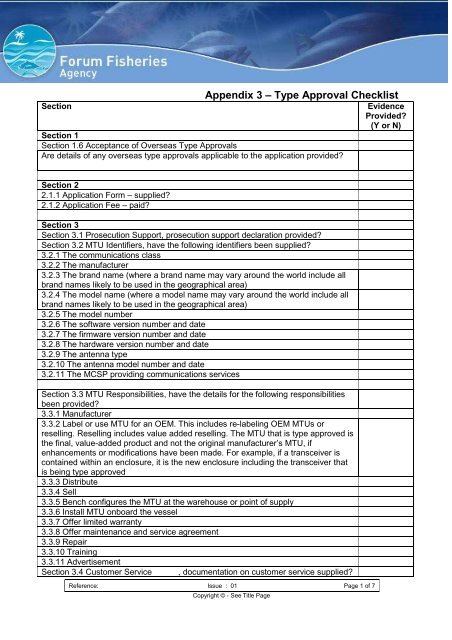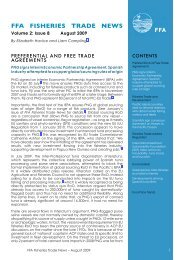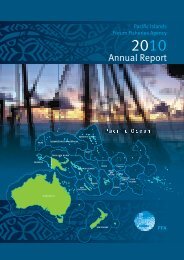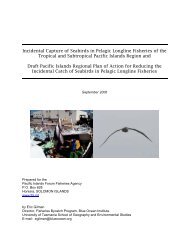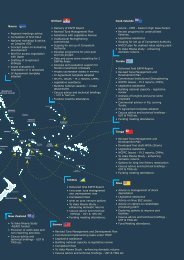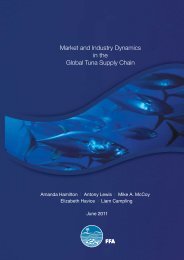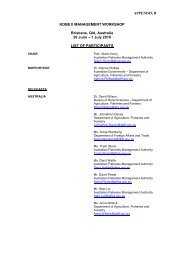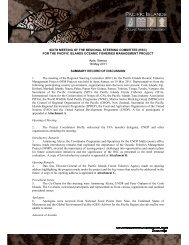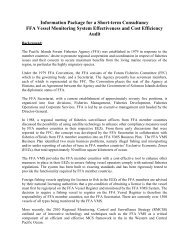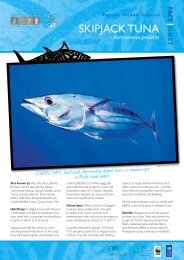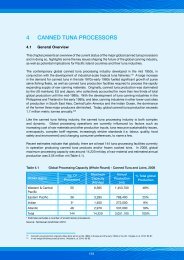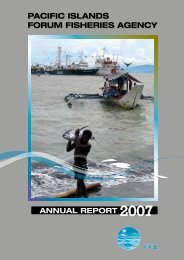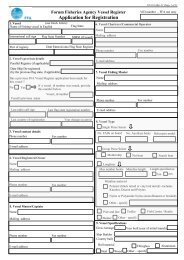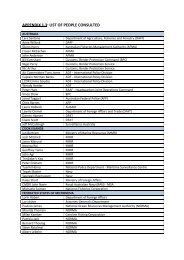2009 Appendix 3 FFA Type Approval Checklist
2009 Appendix 3 FFA Type Approval Checklist
2009 Appendix 3 FFA Type Approval Checklist
You also want an ePaper? Increase the reach of your titles
YUMPU automatically turns print PDFs into web optimized ePapers that Google loves.
Section<br />
<strong>Appendix</strong> 3 – <strong>Type</strong> <strong>Approval</strong> <strong>Checklist</strong><br />
Section 1<br />
Section 1.6 Acceptance of Overseas <strong>Type</strong> <strong>Approval</strong>s<br />
Are details of any overseas type approvals applicable to the application provided<br />
Evidence<br />
Provided<br />
(Y or N)<br />
Section 2<br />
2.1.1 Application Form – supplied<br />
2.1.2 Application Fee – paid<br />
Section 3<br />
Section 3.1 Prosecution Support, prosecution support declaration provided<br />
Section 3.2 MTU Identifiers, have the following identifiers been supplied<br />
3.2.1 The communications class<br />
3.2.2 The manufacturer<br />
3.2.3 The brand name (where a brand name may vary around the world include all<br />
brand names likely to be used in the geographical area)<br />
3.2.4 The model name (where a model name may vary around the world include all<br />
brand names likely to be used in the geographical area)<br />
3.2.5 The model number<br />
3.2.6 The software version number and date<br />
3.2.7 The firmware version number and date<br />
3.2.8 The hardware version number and date<br />
3.2.9 The antenna type<br />
3.2.10 The antenna model number and date<br />
3.2.11 The MCSP providing communications services<br />
Section 3.3 MTU Responsibilities, have the details for the following responsibilities<br />
been provided<br />
3.3.1 Manufacturer<br />
3.3.2 Label or use MTU for an OEM. This includes re-labeling OEM MTUs or<br />
reselling. Reselling includes value added reselling. The MTU that is type approved is<br />
the final, value-added product and not the original manufacturer’s MTU, if<br />
enhancements or modifications have been made. For example, if a transceiver is<br />
contained within an enclosure, it is the new enclosure including the transceiver that<br />
is being type approved<br />
3.3.3 Distribute<br />
3.3.4 Sell<br />
3.3.5 Bench configures the MTU at the warehouse or point of supply<br />
3.3.6 Install MTU onboard the vessel<br />
3.3.7 Offer limited warranty<br />
3.3.8 Offer maintenance and service agreement<br />
3.3.9 Repair<br />
3.3.10 Training<br />
3.3.11 Advertisement<br />
Section 3.4 Customer Service , documentation on customer service supplied<br />
Reference: Issue : 01 Page 1 of 7<br />
Copyright © - See Title Page
Section 3.5 Other Information<br />
3.5.2 Additional requirements – documentation provided<br />
3.5.3 Description of measures against un-authorised disclosure provided<br />
3.5.4 Computer attachment, documentation supplied for these criteria<br />
Section 4<br />
Section 4.1 Evidence provided of the following message functionality<br />
4.1.1 Transmit mandatory, automatically generated position reports.<br />
4.1.2 Onboard visible and/or audible alarms for malfunctioning of the MTU.<br />
4.1.3 Ability to disable non-essential alarms in non-Global Maritime Distress and<br />
Safety System (GMDSS) installations.<br />
4.1.4 Ability to provide comprehensive and transparent communications, which<br />
function uniformly within the entire geographic coverage area for that<br />
communications class.<br />
4.1.5 Two-way communications between MCSP and MTU.<br />
4.1.6 The ability to send and receive free-form Internet email text messages.<br />
4.2.1 Evidence for support of the following position types provided<br />
4.2.1.1 Position fixes latitude and longitude, including the hemisphere of each.<br />
4.2.1.2 The position fix precision must be to the decimal minute hundredths.<br />
4.2.1.3 Accuracy of the reported position must be within 100 meters, unless<br />
otherwise indicated by an existing regulation or VMS requirement.<br />
4.2.2 Evidence provided of mechanisms to prevent the following<br />
4.2.2.1 Interception and ‘‘sniffing’’ during transmission from the MTU to MCSP via<br />
either wireless or terrestrial facilities.<br />
4.2.2.2 Spoofing, whereby one MTU is fraudulently identifying itself as another MTU.<br />
4.2.2.3 Modification of MTU identification.<br />
4.2.2.4 Interference with GMDSS or other safety/distress functions.<br />
4.2.2.5 Introduction of viruses that may corrupt the messages, transmission, or the<br />
VMS system.<br />
4.2.3 Evidence supplied for specific <strong>FFA</strong> rule requirements<br />
4.2.4 Evidence supplied of automatically generated position reports to <strong>FFA</strong><br />
provided<br />
4.2.5 Evidence supplied of ability to store 100 position fixes provided<br />
4.2.6 Evidence supplied of reporting intervals between 5 minutes and 24 hours<br />
4.2.7 Evidence of remotely changing poll interval only by authorised user<br />
4.2.8 Evidence provided that automatically generated position reports contain the<br />
following<br />
4.2.8.1 Unique identification of an MTU within the communications class.<br />
4.2.8.2 Date (year/month/day with century in the year) and time (UTC) stamp of the<br />
position fix.<br />
4.2.9 Evidence supplied of generated position reports in response to the following<br />
4.2.9.1 Antenna disconnection<br />
4.2.9.2 Loss of the positioning reference signals.<br />
4.2.9.3 Loss of the mobile communications signals.<br />
4.2.9.4 Security events, power-up, power-down, and other status data.<br />
4.2.9.5 The vessel crossing a predefined geographic boundary.<br />
4.2.9.6 MTU status information such as configuration of programming and reporting<br />
intervals.<br />
Reference: Issue : 01 Page 2 of 7<br />
Copyright © - See Title Page
4.2.9.7 When an MTU is powered up, it must automatically re-establish its position<br />
reporting function without manual intervention.<br />
Section 5<br />
Section 5.2 Identifiers, are the following identifiers provided<br />
5.2.1 Monitor or terminal model number and date<br />
5.2.2 Monitor or terminal manufacturer<br />
5.2.3 Monitor or terminal software type, version and manufacturer.<br />
Section 6<br />
Section 6.1 Text messaging, evidence provided for the following sections<br />
6.1.1 Text messaging from vessel to shore with a minimum supported message<br />
length of 1kb.<br />
6.1.2 User interface must support an ’address book’ capability and a function<br />
permitting a ‘‘reply’’ to a received message without re-entry of the senders e-mail<br />
address.<br />
6.1.3 A confirmation of delivery function is required such that a user can ascertain<br />
whether a specific message was successfully transmitted via the satellite system to<br />
the MCSP e-mail server(s).<br />
6.1.4 Onward delivery to <strong>FFA</strong> must be reliable and make use of features such as<br />
SMTP retries and delivery confirmation to ensure a reliable transport path exists for<br />
text messages sent from the vessel to <strong>FFA</strong>.<br />
6.1.5 The user interface must provide the ability to review by date order, or by<br />
recipient, messages that were previously sent. The terminal must support a<br />
minimum message history of 20 messages - commonly referred to as an ’Outbox’ or<br />
’Sent’ messages display.<br />
6.1.6 Text messaging from shore to vessel with a minimum supported message<br />
length of 1kb. Attachment support is not required.<br />
6.1.7 The user interface must provide the ability to review by date order, or by<br />
sender, all messages received. The terminal must support a minimum message<br />
history of 20 messages - commonly referred to as an ’Inbox’.<br />
6.1.8 Negative delivery notifications must be sent to the originator where delivery to<br />
the terminal could not be completed for any reason. Such Non Delivery Notification<br />
must include sufficient information to uniquely identify the message that failed and<br />
the cause of failure (i.e., mobile number invalid, mobile switched off etc.).<br />
Section 6.2 Electronic Forms<br />
Evidence provided that E-MTU supports 20 plus user selectable E-forms<br />
Evidence provided that E-forms are updateable over the air<br />
Evidence provided that the following minimum requirements are satisfied<br />
6.2.1 A form is defined as: (a) 1–40 characters describing the form, (b) Delivery<br />
address (i.e., e-mail or other network identifier), (c) Form number as defined by <strong>FFA</strong><br />
to uniquely identify the form, (d) Form version number (numeric with one decimal<br />
place; i.e., 1.2), and (e) a collection of 1–30 fields and associated logic rules.<br />
6.2.2 Each field (within a form) is defined by the following elements. Except where<br />
noted, all elements of the field definition are mandatory: (a) Label (0 to 40<br />
characters, alpha numeric), (b) Context Help Text (0 to 200 characters, alpha<br />
numeric), (c)<strong>Type</strong> (Either; enumeration, numeric, alpha, alphanumeric or Boolean),<br />
(d) Default Value, (e) Optional/Mandatory/Hidden/ Logic indicator, (f) Min/Max values<br />
(for numeric fields only) in range 0.000 to 999,999, (g) Decimal places (for numeric<br />
fields only) 0–3, and (h) Min/Max characters (for alpha/alphanumeric fields only).<br />
Reference: Issue : 01 Page 3 of 7<br />
Copyright © - See Title Page
6.2.3 Up to 100 code/value/help text pairs (enumerations only) must be provided,<br />
where codes are defined as 1– 20 alphanumeric characters, values are 1–80<br />
alphanumeric characters and help text is 0–200 characters. Such fields are typically<br />
used to permit a user to select from a range of options (i.e., geographic areas, gear<br />
types, fish species). Codes are used to compress the form data for efficient<br />
transmission. Help text would typically be displayed only when the user selects a<br />
specific value from the enumeration.<br />
6.2.4 Form Validation<br />
6.2.5 State Information<br />
6.2.6 Inclusion of VMS Position Report<br />
6.2.7 Delivery Format for Form Data<br />
Section 7<br />
Section 7.1 General and 7.2 Marine Use, durability and reliability in a marine<br />
environment – evidence provided<br />
Section 7.3 Operating Temperatures, evidence provided for operating range<br />
Section 7.4 Physical Mounting Requirements, evidence of suitable mounting<br />
provided<br />
Section 7.5 E-MTU Terminal, exposure level to marine environment –<br />
documentation supplied<br />
Section 7.6 Security<br />
7.6.1 Demonstrated tamper resistance and tamper evident<br />
7.6.2 Evidence supplied that not is not reasonably possible to interfere with the<br />
normal operation of the unit via the terminal<br />
Section 8<br />
Section 8.2 Installation guide is part of type approval, installation guide provided<br />
Section 8.3 Mounting the MTU box, evidence provided that fixing for MTU are<br />
suitable for a marine environment<br />
Section 8.4 The E-MTU Terminal, evidence provided that fixing for E-MTU are<br />
suitable for a marine environment<br />
Section 8.5 The Antenna(s)<br />
8.5.1 Mounting, evidence supplied that the antennae and mountings meet this<br />
criteria<br />
8.5.2 The Antenna(s) Cable(s), evidence supplied that the antennae cables meet<br />
this criteria<br />
Section 8.6 The Power Supply, evidence supplied that the power supplies meet this<br />
criteria<br />
Section 10<br />
Section 10.3 Interoperability<br />
Demonstrated interoperability with all MTUs in the same communications class<br />
Section 10.4 Submission<br />
Same class MTU supplied<br />
Communications service supplied<br />
Section 10.5 Litigation Support<br />
Evidence of support in legal cases supplied<br />
Section 10.8 Identifiers, are the following details provided<br />
10.8.1.1 Communications class, including medium, protocol, and frequency of the<br />
Reference: Issue : 01 Page 4 of 7<br />
Copyright © - See Title Page
mobile communications technology.<br />
10.8.1.2 Trade name of the service.<br />
10.5.1.3 Company name.<br />
10.8.1.4 Corporate headquarters.<br />
10.8.1.5 Principal business.<br />
10.8.1.5 Parent and subsidiary companies, if applicable<br />
10.8.1.6 Name and locations of principal terrestrial facilities, e.g., downlinks,<br />
gateways, switches, and operation centres.<br />
10.8.2.1 Satellite: MCSP must provide adequate orbit types, constellation size, and<br />
coverage footprint to provide comprehensive coverage of the VMS fishery for which<br />
application is made<br />
10.8.2.2 Cellular: MCSP must provide adequate coverage footprints, tower<br />
distribution density, tower locations, and protocols required to provide<br />
comprehensive coverage of the VMS fishery for which application is made.<br />
10.8.2.3 Radio: MCSP must provide adequate coast stations, locations, antennas,<br />
and antenna size to provide comprehensive coverage of the VMS fishery for which<br />
application is made.<br />
10.8.2.4 Approved or pending approval MTU(s) supported.<br />
10.8.3.1 Operate principal terrestrial facilities<br />
10.8.3.2 Operate principal wireless facilities<br />
10.8.4.1 Direct sales<br />
10.8.4.2 Indirect/distributor/channel sales<br />
10.8.4.3 Billing<br />
10.8.4.4 Account management<br />
10.8.4.5 Customer service<br />
10.8.4.6 Technical support<br />
10.8.4.7 Public affairs<br />
10.8.4.8 Advertising<br />
Section 10.9 Messaging, evidence provided for support of the following messaging<br />
functions<br />
10.9.1.1 Automatically generated position reports<br />
10.9.1.2 Event-driven position reports<br />
10.9.1.3 Safety and distress alerts and messages<br />
10.9.1.4 Email text messages<br />
10.9.1.5 Ability to remotely create new message-types<br />
10.9.1.6 Email forms<br />
10.9.2.1 Ability to perform two-way messaging<br />
10.9.2.2 Ability for <strong>FFA</strong> to initiate communications to vessels, either individually or by<br />
originator-defined groups of vessels.<br />
Section 10.10 Position Data Formats and Transmission, evidence provided for the<br />
following automatically generated position reports<br />
10.10.1 Position fix latitude and longitude, including the hemisphere of each.<br />
10.10.2 The precision of the position fix shall be to the decimal minute hundredths.<br />
10.10.3 Accuracy of the position fix must be within 100 meters, unless otherwise<br />
indicated by an <strong>FFA</strong> requirement.<br />
10.10.4 Unique identification of an MTU within the communications class.<br />
10.10.5 Date (year/month/day with century in the year) and time (UTC) stamp of the<br />
position fix.<br />
10.10.6 Date (year/month/day with century in the year) and time (UTC) when the<br />
Reference: Issue : 01 Page 5 of 7<br />
Copyright © - See Title Page
position report is received at the MCSP.<br />
10.10.7 Date (year/month/day with century in the year) and time (UTC) stamp when<br />
the position report is sent to <strong>FFA</strong>.<br />
10.10.8 MTU status information, such as configuration of programming and reporting<br />
intervals, power save modes, antenna disconnection, and power-up/ power down,<br />
and loss of positioning signal.<br />
Section 10.11 Special Identified Position Reports<br />
Evidence supplied for specially identified position reports<br />
10.11.1 Loss of the positioning reference signals<br />
10.11.2 Loss of the mobile communications signals<br />
10.11.3 Security events and other status data<br />
10.11.4 The vessel crossing a predefined geographic boundary<br />
10.11.5 10.11.5 Automatically generated position reports sent to <strong>FFA</strong> from the<br />
MCSP must be in a format compatible with <strong>FFA</strong> vessel monitoring software.<br />
Section 10.12 Queries<br />
Evidence supplied for the following queries<br />
10.12.1.1 Vessels presently located within a geographic area (for example, defined<br />
by a circle or a rectangle, used by fisheries patrol vessels for operations)<br />
10.12.1.2 Vessels that are members of an <strong>FFA</strong> defined logical grouping (For<br />
example, grouped by fish type, gear type, or region of home port)<br />
10.12.4.1 Reprogramming or reconfiguring position reporting features.<br />
10.12.4.2 Determining current position.<br />
10.12.4.3 Extracting feature states, such as sensor status.<br />
Section 10.13 Position Intervals<br />
Evidence supplied for support of remotely programmed reporting intervals<br />
Section 10.14 Latency<br />
Evidence supplied for Latency between position fix and <strong>FFA</strong> of MCSP<br />
Section 10.15 Terrestrial Connectivity<br />
Evidence supplied for the following connectivity’s<br />
10.15.1.1 Redundancy of terrestrial facilities and network connectivity between<br />
MCSP and <strong>FFA</strong>, such that backup circuits or alternate network types automatically<br />
replace the primary in the event of failure without any manual intervention.<br />
10.15.1.2 Two-way communications for delivery and acceptance of data from MCSP<br />
to <strong>FFA</strong> and back, supporting messages, position reports, queries and administrative<br />
functions.<br />
10.15.1.3 Auto-forwarding or auto-delivery of messages without the need for<br />
retrieval by <strong>FFA</strong>.<br />
10.15.1.4 Geographically transparent communications from <strong>FFA</strong> to the MTU, such<br />
that <strong>FFA</strong> seamlessly performs communication functions without a need to take<br />
additional steps to accommodate the geographic region where the vessel is fishing.<br />
10.15.2 Evidence provided of Latency between MCSP and <strong>FFA</strong><br />
10.15.3 Evidence of mechanism provided to ensure reasonable protection against<br />
the following<br />
10.15.3.1 Tampering or interception, including the reading of passwords and data.<br />
10.15.3.2 Interception and ‘‘sniffing’’ during transmission from the MCSP to <strong>FFA</strong> via<br />
either wireless or terrestrial facilities.<br />
10.15.3.3 Spoofing, whereby one MTU is fraudulently identifying itself as another<br />
MTU.<br />
Reference: Issue : 01 Page 6 of 7<br />
Copyright © - See Title Page
10.15.3.4 Modification of MTU identification.<br />
10.15.3.5 Interference with Global Maritime Distress and Safety System (GMDSS) or<br />
other safety/distress functionalities.<br />
10.15.3.6 Introduction of viruses that may corrupt the messages, transmission, or<br />
the VMS system.<br />
10.16.1 Evidence provided for the following wireless features<br />
10.16.1.1 Redundancy of wireless facilities and network connectivity between MTU<br />
and <strong>FFA</strong>, such that backup circuits or alternate network types automatically replace<br />
the primary in the event of failure without any manual intervention.<br />
10.16.1.2 Geographically transparent communications to and from <strong>FFA</strong> and the<br />
MTU, such that <strong>FFA</strong> seamlessly performs communication functions without a need<br />
to take additional steps to accommodate the geographic region where the vessel is<br />
fishing<br />
10.16.1.3 Durability and reliability in a marine environment, without signal<br />
degradation or other loss of integrity from adverse meteorological conditions.<br />
10.16.2 Evidence provided of reasonable mechanisms to prevent the following<br />
10.16.2.1 Interception and ‘‘sniffing’’ during transmission to and from the MCSP and<br />
MTU via either wireless or terrestrial facilities.<br />
10.16.2.2 Spoofing, whereby one MTU is fraudulently identifying itself as another<br />
MTU.<br />
10.16.2.3 Modification of MTU identification.<br />
10.16.2.4 Interference with GMDSS or other safety/distress functionalities.<br />
10.16.2.5 Introduction of viruses that may corrupt the messages, transmission, or<br />
the VMS system.<br />
10.17.1 Evidence provided on Customer service<br />
10.17.2 Evidence of measures for the protection of the following provided<br />
10.17.2.1 Prevent unauthorised access to data and configuration information by<br />
MCSP employees and third parties.<br />
10.17.2.2 Authorise fishermen access to account info and to enhance the MTU<br />
configuration for personal messages, if they pay for the costs of personal messages<br />
and configuration changes do not affect the integrity of VMS operations.<br />
10.17.2.3 Send the MTU email, poll or remotely reconfigure the MTU for position<br />
reporting changes upon <strong>FFA</strong> request.<br />
10.17.2.4 Keep an audit trail of actions taken by Customer Service.<br />
10.17.3 Evidence provided that 10.17.2 applies to single and a group pf MTUs<br />
10.17.4 Service level agreements clarify constraints (if any) on the geographic<br />
territory, personnel availability, and escalation procedures for problem resolution<br />
covered by such services<br />
10.17.5 Evidence of provision of assistance in the resolution of communication<br />
anomalies and finding their cause provided<br />
10.17.6 Provided documented MTU commissioning procedures for <strong>FFA</strong> vessels<br />
10.17.7 Provided documented account and service activation procedures<br />
10.17.8 Provide documented and secure MTU configuration strategy or procedures<br />
for vessels monitored singly or grouped by fleet<br />
10.17.9 Evidence provided to support this section<br />
Section 12 - TEST PLAN<br />
<strong>Appendix</strong> 1 - Test plan completed<br />
Reference: Issue : 01 Page 7 of 7<br />
Copyright © - See Title Page


